Enhancing Subsurface Soil Moisture Forecasting: A Long Short-Term Memory Network Model Using Weather Data
Abstract
1. Introduction
2. Materials and Methods
2.1. Study Area and Data Used
2.2. Time Series Analysis
2.3. Model Development for Subsurface Soil Moisture Forecasting
2.4. Development of a VAR Model
2.4.1. Selection of Lag Order
2.4.2. Construction of Model Equation
2.4.3. VAR Model Evaluation
2.5. Development of an LSTM Model
2.5.1. Architecture of the LSTM Model
2.5.2. Training the LSTM Model
2.5.3. Overfitting and Underfitting Test of LSTM Model
2.5.4. Testing the LSTM Model
3. Results and Discussions
3.1. Subsurface Soil Water Content in Response to Weather Variables
3.2. Time Series Analysis of the Variables
3.2.1. Analysis of Historical Subsurface Soil Moisture Data
3.2.2. Seasonality of Moisture Content
3.2.3. Autocorrelation Test of Variables
3.2.4. Stationarity Test
3.2.5. Cointegration Test
3.2.6. Forecastability Test
3.3. Model Development and Evaluation of Subsurface VWC Forecast
3.3.1. Statistical Model: Vector Autoregression (VAR)
3.3.2. Evaluation of the VAR Model
3.3.3. The LSTM Network Model
3.3.4. Evaluation of the LSTM Network Model
4. Conclusions
Author Contributions
Funding
Institutional Review Board Statement
Data Availability Statement
Acknowledgments
Conflicts of Interest
References
- Moebius-Clune, B.N.; Moebius-Clune, D.J.; Schindelbeck, R.R.; Kurtz, K.S.M.; van Es, H.M.; Ristow, A.J. Comprehensive Assessment of Soil Health: The Cornell Framework Manual, 3rd ed.; Cornell University: Ithaca, NY, USA, 2016; ISBN 978-0-9676507-6-0. [Google Scholar]
- Bertolino, A.V.F.A.; Fernandes, N.F.; Miranda, J.P.L.; Souza, A.P.; Lopes, M.R.S.; Palmieri, F. Effects of Plough Pan Development on Surface Hydrology and on Soil Physical Properties in Southeastern Brazilian Plateau. J. Hydrol. 2010, 393, 94–104. [Google Scholar] [CrossRef]
- Brubaker, K.L.; Entekhabi, D. Analysis of Feedback Mechanisms in Land-Atmosphere Interaction. Water Resour. Res. 1996, 32, 1343–1357. [Google Scholar] [CrossRef]
- Vlce, J.; King, D. Detection of Subsurface Soil Moisture by Thermal Sensing: Results of Laboratory, Close-Range, and Aerial Studies. Photogramm. Eng. Remote Sens. 1983, 49, 1593–1597. [Google Scholar]
- Babeir, A.S.; Colvin, T.S.; Marley, S.J. Predicting Field Tractability with a Simulation Model. Trans. ASAE 1986, 29, 1520–1525. [Google Scholar] [CrossRef]
- Dickey, E.; Peterson, T.; Eisenhauer, D.E.; Jasa, P. Soil Compaction I Where, How Bad, a Problem. In Biological Systems Engineering: Papers and Publications; University of Nebraska at Lincoln: Lincoln, NE, USA, 1985. [Google Scholar]
- Soane, B.D.; van Ouwerkerk, C. Implications of Soil Compaction in Crop Production for the Quality of the Environment. Soil Tillage Res. 1995, 35, 5–22. [Google Scholar] [CrossRef]
- Ren, L.; D’Hose, T.; Ruysschaert, G.; De Pue, J.; Meftah, R.; Cnudde, V.; Cornelis, W.M. Effects of Soil Wetness and Tyre Pressure on Soil Physical Quality and Maize Growth by a Slurry Spreader System. Soil Tillage Res. 2019, 195, 104344. [Google Scholar] [CrossRef]
- Gill, M.K.; Asefa, T.; Kemblowski, M.W.; McKee, M. Soil Moisture Prediction Using Support Vector Machines1. JAWRA J. Am. Water Resour. Assoc. 2006, 42, 1033–1046. [Google Scholar] [CrossRef]
- Saxton, K.E.; Johnson, H.P.; Shaw, R.H. Modeling Evapotranspiration and Soil Moisture. Trans. ASAE 1974, 17, 673–0677. [Google Scholar] [CrossRef]
- Holtan, N.H. USDAHL-74 Revised Model of Watershed Hydrology: A United States Contribution to the International Hydrological Decade; Agricultural Research Service, U.S. Department of Agriculture: Washington, DC, USA, 1975.
- Peck, E.L. Catchment Modeling and Initial Parameter Estimation for the National Weather Service River Forecast System; Office of Hydrology, National Weather Service: Silver Spring, MD, USA, 1976.
- Huth, N.I.; Bristow, K.L.; Verburg, K. SWIM3: Model Use, Calibration, and Validation. Trans. ASABE 2012, 55, 1303–1313. [Google Scholar] [CrossRef]
- Rotz, C.A.; Corson, M.S.; Chianese, D.S.; Hafner, S.D.; Bonifacio, H.F.; Coiner, U. The Integrated Farm System Model; Pasture Systems and Watershed Management Research Unit, Agricultural Research Service, United States Department of Agriculture: Washington, DC, USA, 2020; p. 253.
- Elshorbagy, A.; Parasuraman, K. On the Relevance of Using Artificial Neural Networks for Estimating Soil Moisture Content. J. Hydrol. 2008, 362, 1–18. [Google Scholar] [CrossRef]
- Kornelsen, K.C.; Coulibaly, P. Root-Zone Soil Moisture Estimation Using Data-Driven Methods. Water Resour. Res. 2014, 50, 2946–2962. [Google Scholar] [CrossRef]
- Liu, Y.; Mei, L.; Ki, S.O. Prediction of Soil Moisture Based on Extreme Learning Machine for an Apple Orchard. In Proceedings of the 2014 IEEE 3rd International Conference on Cloud Computing and Intelligence Systems, Shenzhen, China, 27–29 November 2014; pp. 400–404. [Google Scholar]
- Zaman, B.; McKee, M. Spatio-temporal prediction of root zone soil moisture using multivariate relevance vector machines. Open J. Mod. Hydrol. 2014, 4, 80–90. [Google Scholar] [CrossRef]
- Matei, O.; Rusu, T.; Petrovan, A.; Mihuţ, G. A Data Mining System for Real Time Soil Moisture Prediction. Procedia Eng. 2017, 181, 837–844. [Google Scholar] [CrossRef]
- Prakash, S.; Sharma, A.; Sahu, S.S. Soil Moisture Prediction Using Machine Learning. In Proceedings of the 2018 Second International Conference on Inventive Communication and Computational Technologies (ICICCT), Coimbatore, India, 20–21 April 2018; pp. 1–6. [Google Scholar]
- Wang, G.; Han, Y.; Chang, J. Research on Soil Moisture Content Combination Prediction Model Based on ARIMA and BP Neural Networks. Adv. Control. Appl. 2023, e139. [Google Scholar] [CrossRef]
- Singh, S.; Kaur, S.; Kumar, P. Forecasting Soil Moisture Based on Evaluation of Time Series Analysis. In Proceedings of the Advances in Power and Control Engineering; Singh, S.N., Pandey, R.K., Panigrahi, B.K., Kothari, D.P., Eds.; Springer: Singapore, 2020; pp. 145–156. [Google Scholar]
- Yu, J.; Zhang, X.; Xu, L.; Dong, J.; Zhangzhong, L. A Hybrid CNN-GRU Model for Predicting Soil Moisture in Maize Root Zone. Agric. Water Manag. 2021, 245, 106649. [Google Scholar] [CrossRef]
- Jiang, S.; Chen, G.; Chen, D.; Chen, T. Application and Evaluation of an Improved LSTM Model in the Soil Moisture Prediction of Southeast Chinese Tobacco-Producing Areas. J. Indian Soc. Remote Sens. 2022, 51, 1843–1853. [Google Scholar] [CrossRef]
- Choudhary, R.; Athira, P. Effect of Root Zone Soil Moisture on the SWAT Model Simulation of Surface and Subsurface Hydrological Fluxes. Environ. Earth Sci. 2021, 80, 620. [Google Scholar] [CrossRef]
- Xu, Z.; Man, X.; Duan, L.; Cai, T. Improved Subsurface Soil Moisture Prediction from Surface Soil Moisture through the Integration of the (de)Coupling Effect. J. Hydrol. 2022, 608, 127634. [Google Scholar] [CrossRef]
- Carranza, C.; Nolet, C.; Pezij, M.; van der Ploeg, M. Root Zone Soil Moisture Estimation with Random Forest. J. Hydrol. 2021, 593, 125840. [Google Scholar] [CrossRef]
- Basak, A.; Schmidt, K.M.; Mengshoel, O.J. From Data to Interpretable Models: Machine Learning for Soil Moisture Forecasting. Int. J. Data Sci. Anal. 2023, 15, 9–32. [Google Scholar] [CrossRef]
- A, Y.; Jiang, X.; Wang, Y.; Wang, L.; Zhang, Z.; Duan, L.; Fang, Q. Study on Spatio-Temporal Simulation and Prediction of Regional Deep Soil Moisture Using Machine Learning. J. Contam. Hydrol. 2023, 258, 104235. [Google Scholar] [CrossRef]
- Santos, L.B.L.; Freitas, C.P.; Bacelar, L.; Soares, J.A.J.P.; Diniz, M.M.; Lima, G.R.T.; Stephany, S. A Neural Network-Based Hydrological Model for Very High-Resolution Forecasting Using Weather Radar Data. Eng 2023, 4, 1787–1796. [Google Scholar] [CrossRef]
- Hou, P.S.; Fadzil, L.M.; Manickam, S.; Al-Shareeda, M.A. Vector Autoregression Model-Based Forecasting of Reference Evapotranspiration in Malaysia. Sustainability 2023, 15, 3675. [Google Scholar] [CrossRef]
- Abdallah, W.; Abdallah, N.; Marion, J.-M.; Oueidat, M.; Chauvet, P. A Vector Autoregressive Methodology for Short-Term Weather Forecasting: Tests for Lebanon. SN Appl. Sci. 2020, 2, 1555. [Google Scholar] [CrossRef]
- Bahari, N.A.A.B.S.; Ahmed, A.N.; Chong, K.L.; Lai, V.; Huang, Y.F.; Koo, C.H.; Ng, J.L.; El-Shafie, A. Predicting Sea Level Rise Using Artificial Intelligence: A Review. Arch. Comput. Methods Eng. 2023, 30, 4045–4062. [Google Scholar] [CrossRef]
- Wai, K.P.; Chia, M.Y.; Koo, C.H.; Huang, Y.F.; Chong, W.C. Applications of Deep Learning in Water Quality Management: A State-of-the-Art Review. J. Hydrol. 2022, 613, 128332. [Google Scholar] [CrossRef]
- Ng, K.W.; Huang, Y.F.; Koo, C.H.; Chong, K.L.; El-Shafie, A.; Najah Ahmed, A. A Review of Hybrid Deep Learning Applications for Streamflow Forecasting. J. Hydrol. 2023, 625, 130141. [Google Scholar] [CrossRef]
- Fan, H.; Jiang, M.; Xu, L.; Zhu, H.; Cheng, J.; Jiang, J. Comparison of Long Short Term Memory Networks and the Hydrological Model in Runoff Simulation. Water 2020, 12, 175. [Google Scholar] [CrossRef]
- Indiana Geological and Water Survey Springs and IWBN API Docs. Available online: https://igws.indiana.edu/water/api_doc#/IWBN/get_iwbn_observations_daily (accessed on 7 May 2023).
- Durbin, J.; Watson, G.S. TESTING FOR SERIAL CORRELATION IN LEAST SQUARES REGRESSION. II. Biometrika 1951, 38, 159–178. [Google Scholar] [CrossRef] [PubMed]
- Durbin, J.; Watson, G.S. TESTING FOR SERIAL CORRELATION IN LEAST SQUARES REGRESSION. I. Biometrika 1950, 37, 409–428. [Google Scholar] [CrossRef] [PubMed]
- Mushtaq, R. Augmented Dickey Fuller Test; Social Science Research Network: Rochester, NY, USA, 2011. [Google Scholar]
- Johansen, S. Estimation and Hypothesis Testing of Cointegration Vectors in Gaussian Vector Autoregressive Models. Econometrica 1991, 59, 1551–1580. [Google Scholar] [CrossRef]
- Granger, C.W.J. Causality, Cointegration, and Control. J. Econ. Dyn. Control 1988, 12, 551–559. [Google Scholar] [CrossRef]
- TjØstheim, D. Granger-Causality in Multiple Time Series. J. Econom. 1981, 17, 157–176. [Google Scholar] [CrossRef]
- Miller, M. The Basics: Time Series and Seasonal Decomposition. Available online: https://towardsdatascience.com/the-basics-time-series-and-seasonal-decomposition-b39fef4aa976 (accessed on 8 March 2022).
- Ali, M.M. Durbin–Watson and Generalized Durbin–Watson Tests for Autocorrelations and Randomness. J. Bus. Econ. Stat. 1987, 5, 195–203. [Google Scholar] [CrossRef]
- Montgomery, D.C.; Jennings, C.L.; Kulahci, M. Introduction to Time Series Analysis and Forecasting; John Wiley & Sons: Hoboken, NJ, USA, 2015; ISBN 978-1-118-74515-1. [Google Scholar]
- Witt, A.; Kurths, J.; Pikovsky, A. Testing Stationarity in Time Series. Phys. Rev. E 1998, 58, 1800–1810. [Google Scholar] [CrossRef]
- Stock, J.H.; Watson, M.W. Vector Autoregressions. J. Econ. Perspect. 2001, 15, 101–115. [Google Scholar] [CrossRef]
- Akaike, H. Fitting Autoregressive Models for Prediction. Ann. Inst. Stat. Math. 1969, 21, 243–247. [Google Scholar] [CrossRef]
- Akaike, H. A New Look at the Statistical Model Identification. IEEE Trans. Autom. Control 1974, 19, 716–723. [Google Scholar] [CrossRef]
- Chao, J.C.; Phillips, P.C.B. Model Selection in Partially Nonstationary Vector Autoregressive Processes with Reduced Rank Structure. J. Econom. 1999, 91, 227–271. [Google Scholar] [CrossRef]
- Gredenhoff, M.; Karlsson, S. Lag-Length Selection in VAR-Models Using Equal and Unequal Lag-Length Procedures. Comput. Stat. 1999, 14, 171–187. [Google Scholar] [CrossRef]
- Holtz-Eakin, D.; Newey, W.; Rosen, H.S. Estimating Vector Autoregressions with Panel Data. Econometrica 1988, 56, 1371–1395. [Google Scholar] [CrossRef]
- Wallach, D.; Goffinet, B. Mean Squared Error of Prediction as a Criterion for Evaluating and Comparing System Models. Ecol. Model. 1989, 44, 299–306. [Google Scholar] [CrossRef]
- Hodson, T.O. Root Mean Square Error (RMSE) or Mean Absolute Error (MAE): When to Use Them or Not. Geosci. Model Dev. Discuss. 2022, 15, 1–10. [Google Scholar] [CrossRef]
- Kingma, D.P.; Ba, J. Adam: A Method for Stochastic Optimization. arXiv 2017, arXiv:1412.6980. [Google Scholar] [CrossRef]
- Géron, A. Hands-On Machine Learning with Scikit-Learn, Keras, and TensorFlow: Concepts, Tools, and Techniques to Build Intelligent Systems; O’Reilly Media, Inc.: Sebastopol, CA, USA, 2019; ISBN 978-1-4920-3259-5. [Google Scholar]
- Karlik, B.; Olgac, A.V. Performance Analysis of Various Activation Functions in Generalized MLP Architectures o. IJAE 2010, 1, 111–122. [Google Scholar]
- Baheti, P. 12 Types of Neural Networks Activation Functions: How to Choose? Available online: https://www.v7labs.com/blog/neural-networks-activation-functions (accessed on 20 February 2022).
- Sharma, S.; Sharma, S.; Athaiya, A. ACTIVATION FUNCTIONS IN NEURAL NETWORKS. IJEAST 2017, 4, 310–316. [Google Scholar] [CrossRef]
- Fiorentini, N.; Pellegrini, D.; Losa, M. Overfitting Prevention in Accident Prediction Models: Bayesian Regularization of Artificial Neural Networks. Transp. Res. Rec. 2023, 2677, 1455–1470. [Google Scholar] [CrossRef]
- Chakraborty, A.; Mukherjee, D.; Mitra, S. Development of Pedestrian Crash Prediction Model for a Developing Country Using Artificial Neural Network. Int. J. Inj. Control Saf. Promot. 2019, 26, 283–293. [Google Scholar] [CrossRef]
- Miles, J. R Squared, Adjusted R Squared. In Wiley StatsRef: Statistics Reference Online; John Wiley & Sons, Ltd.: Hoboken, NJ, USA, 2014; ISBN 978-1-118-44511-2. [Google Scholar]
- Salaeh, N.; Ditthakit, P.; Pinthong, S.; Hasan, M.A.; Islam, S.; Mohammadi, B.; Linh, N.T.T. Long-Short Term Memory Technique for Monthly Rainfall Prediction in Thale Sap Songkhla River Basin, Thailand. Symmetry 2022, 14, 1599. [Google Scholar] [CrossRef]
- Vassoler, R.T.; Zebende, G.F. DCCA Cross-Correlation Coefficient Apply in Time Series of Air Temperature and Air Relative Humidity. Phys. A Stat. Mech. Its Appl. 2012, 391, 2438–2443. [Google Scholar] [CrossRef]
- Flores, J.H.F.; Engel, P.M.; Pinto, R.C. Autocorrelation and Partial Autocorrelation Functions to Improve Neural Networks Models on Univariate Time Series Forecasting. In Proceedings of the 2012 International Joint Conference on Neural Networks (IJCNN), Brisbane, QLD, Australia, 10–15 June 2012; pp. 1–8. [Google Scholar]
- Inder, B. An Approximation to the Null Distribution of the Durbin-Watson Statistic in Models Containing Lagged Dependent Variables. Econom. Theory 1986, 2, 413–428. [Google Scholar] [CrossRef]
- Franses, P.H. A Multivariate Approach to Modeling Univariate Seasonal Time Series. J. Econom. 1994, 63, 133–151. [Google Scholar] [CrossRef]
- Osińska, M. On the Interpretation of Causality in Granger’s Sense. O Interpret. Przyczynowości W Sensie Grangera 2011, 11, 129–140. [Google Scholar] [CrossRef]
- Santosa, S.; Santosa, Y.P.; Goro, G.L.; Wahjoedi; Mahbub, J. Computational of Concrete Slump Model Based on H2O Deep Learning Framework and Bagging to Reduce Effects of Noise and Overfitting. JOIV Int. J. Inform. Vis. 2023, 7, 370–376. [Google Scholar] [CrossRef]
- Behroozi-Khazaei, N.; Nasirahmadi, A. A Neural Network Based Model to Analyze Rice Parboiling Process with Small Dataset. J. Food Sci. Technol. 2017, 54, 2562–2569. [Google Scholar] [CrossRef] [PubMed]
- O’Callaghan, J.R.; Menzies, D.J.; Bailey, P.H. Digital Simulation of Agricultural Drier Performance. J. Agric. Eng. Res. 1971, 16, 223–244. [Google Scholar] [CrossRef]
- Berry, W.D. Understanding Regression Assumptions; Quantitative Application in the Social Sciences; SAGE: Newcastle upon Tyne, UK, 1993; ISBN 978-0-8039-4263-9. [Google Scholar]
- Han, H.; Choi, C.; Kim, J.; Morrison, R.R.; Jung, J.; Kim, H.S. Multiple-Depth Soil Moisture Estimates Using Artificial Neural Network and Long Short-Term Memory Models. Water 2021, 13, 2584. [Google Scholar] [CrossRef]
- Kumar, M.T.; Rao, M.C. Studies on Predicting Soil Moisture Levels at Andhra Loyola College, India, Using SARIMA and LSTM Models. Environ. Monit. Assess. 2023, 195, 1426. [Google Scholar] [CrossRef]
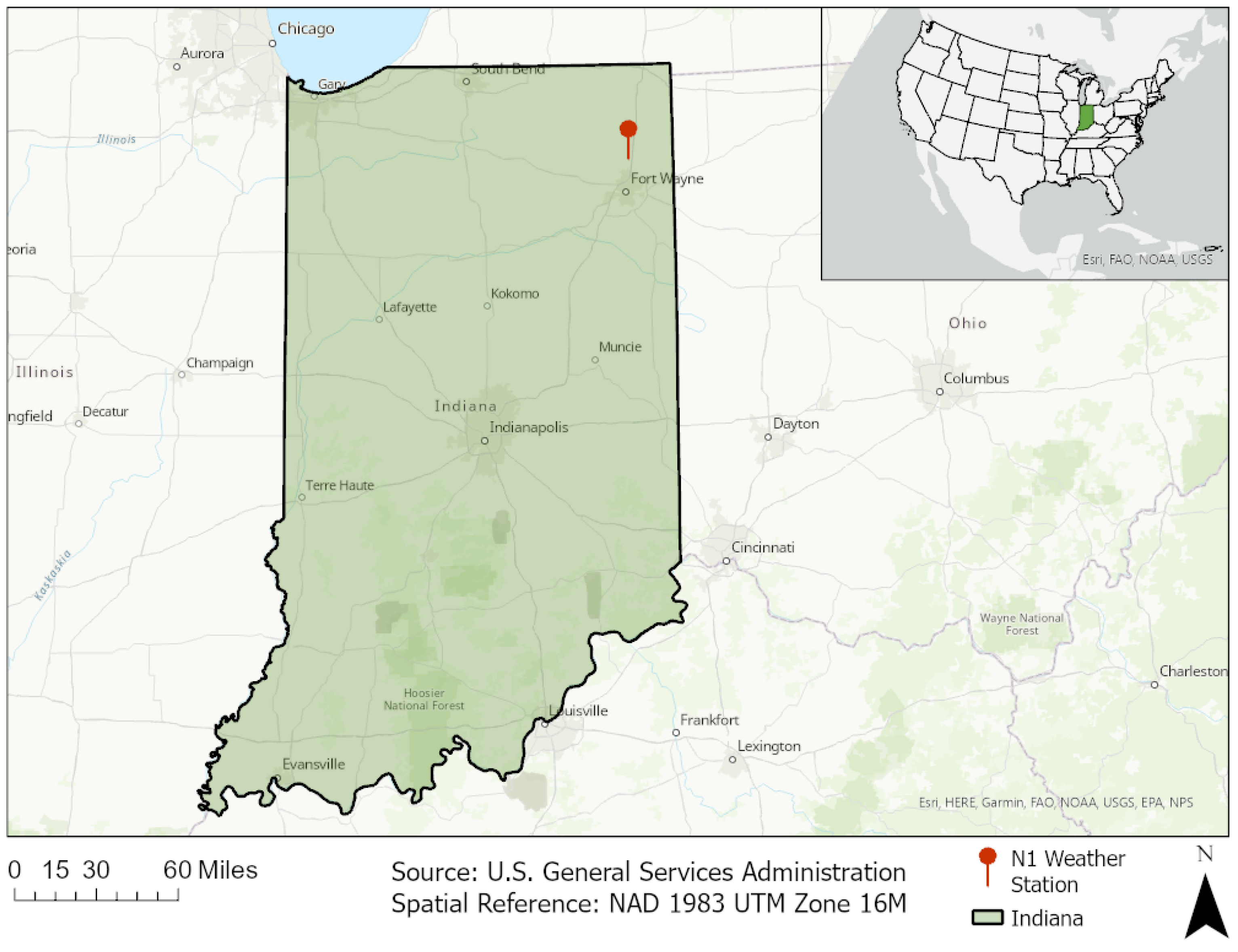

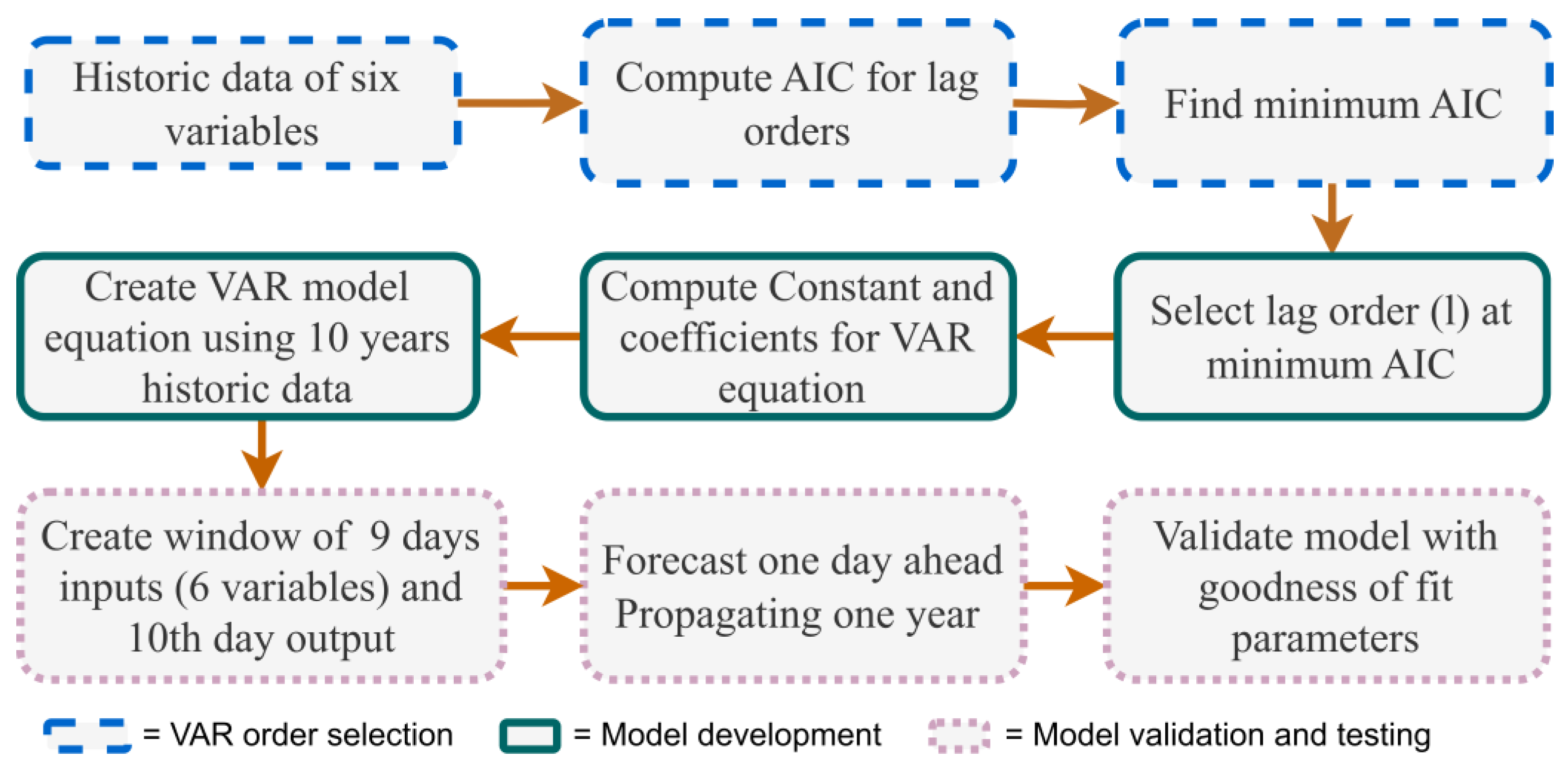
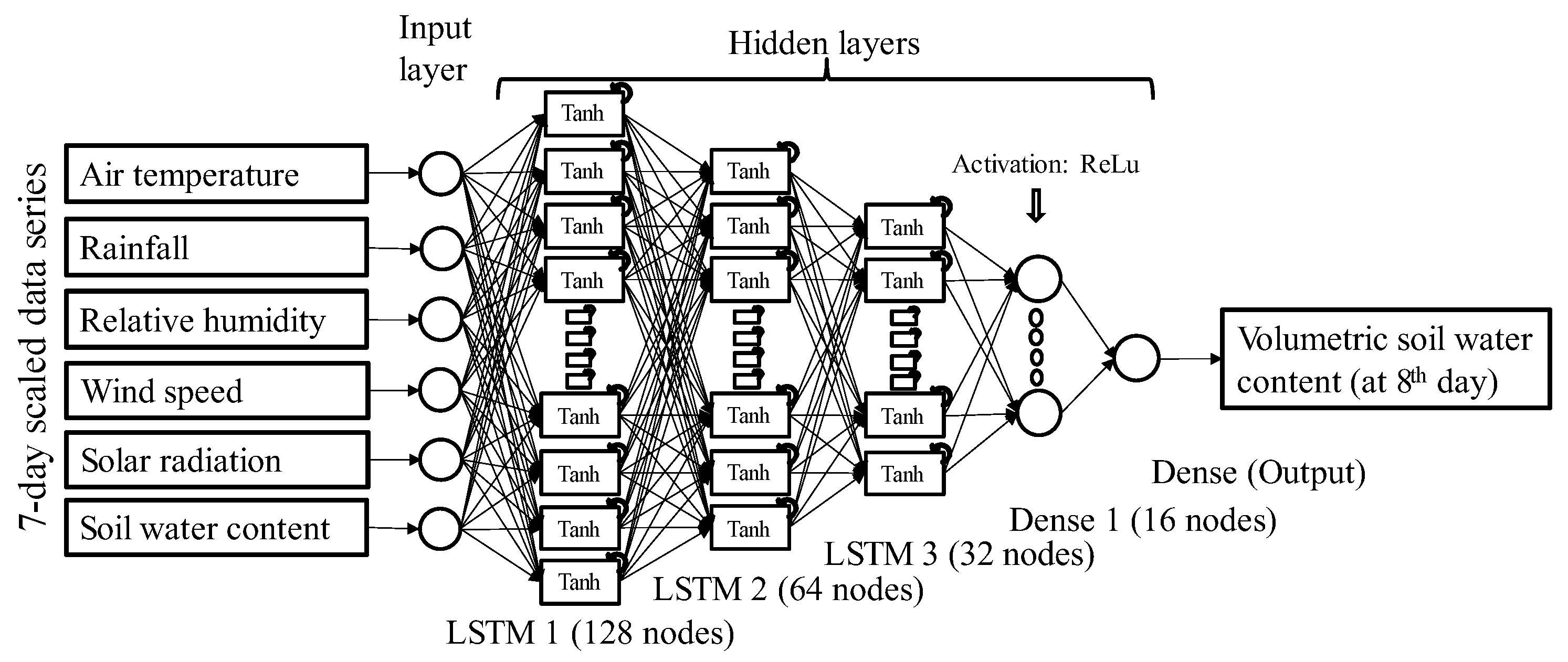
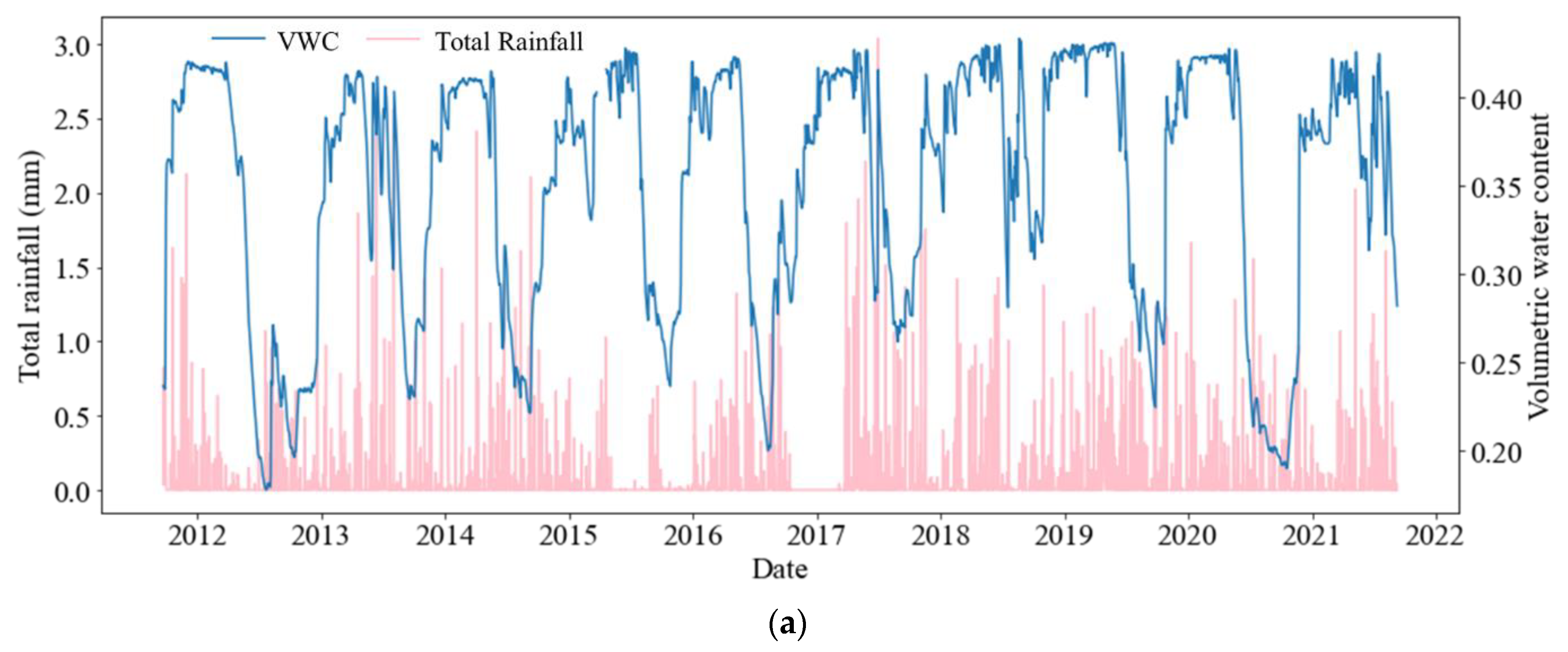
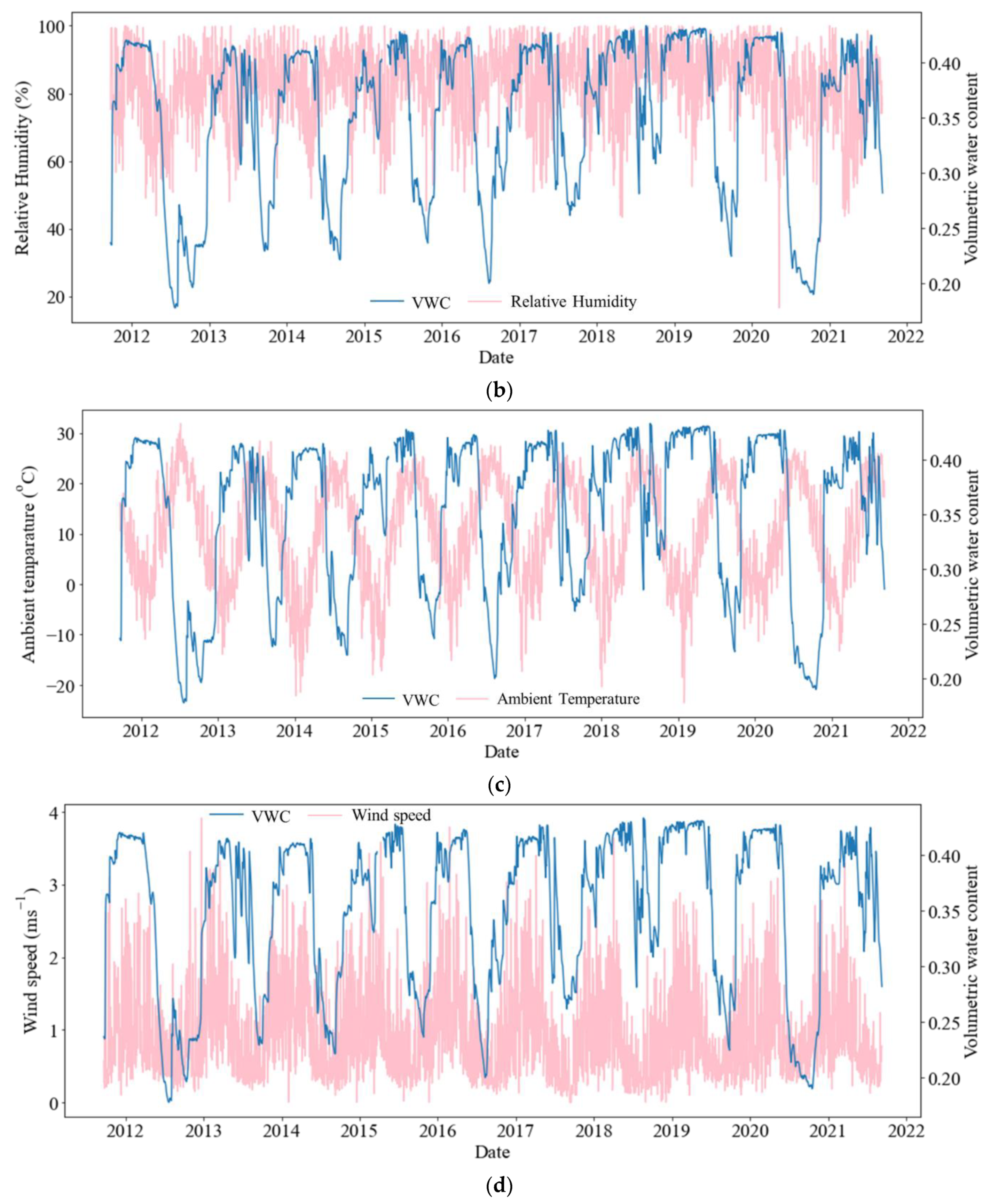

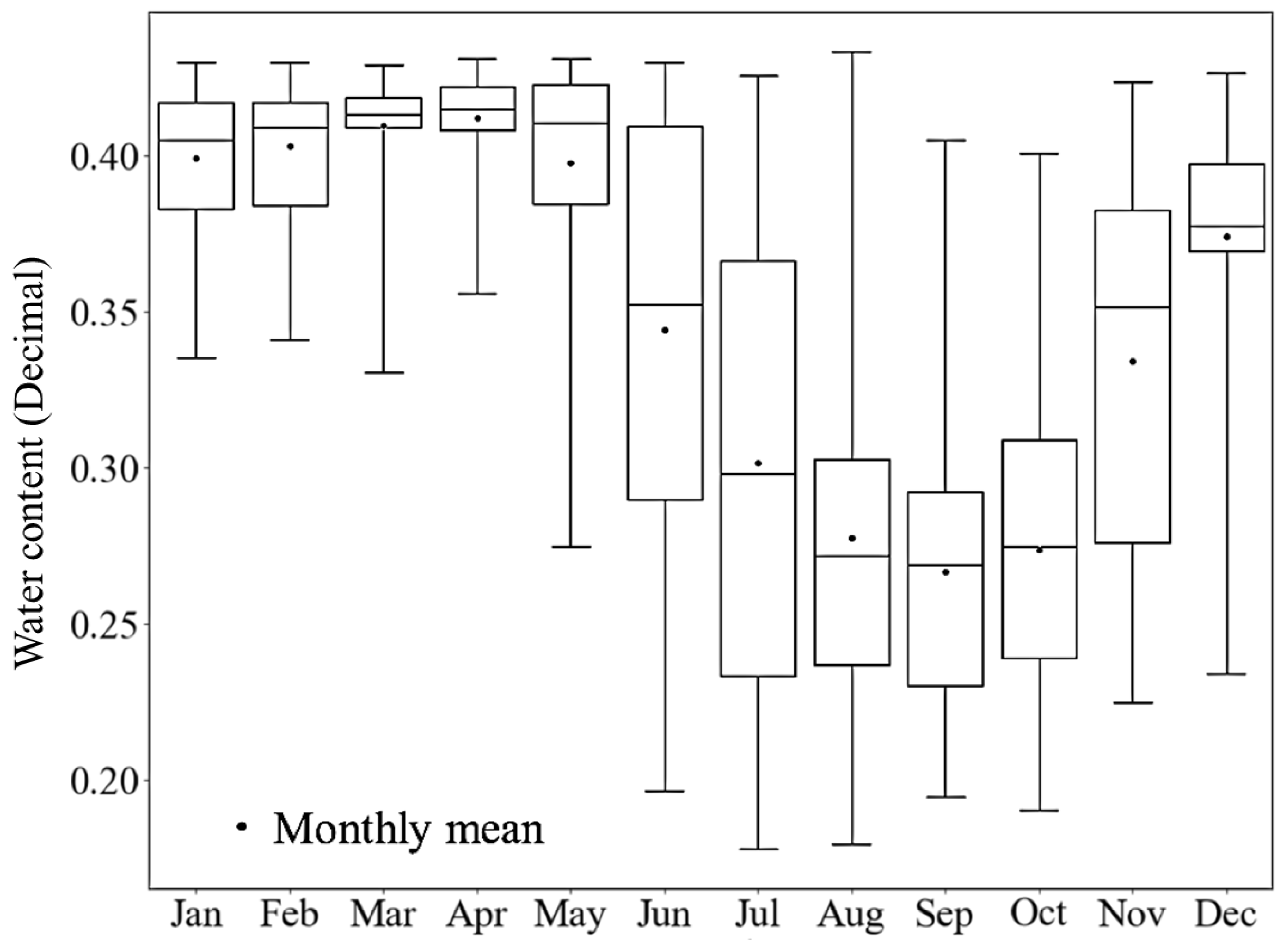
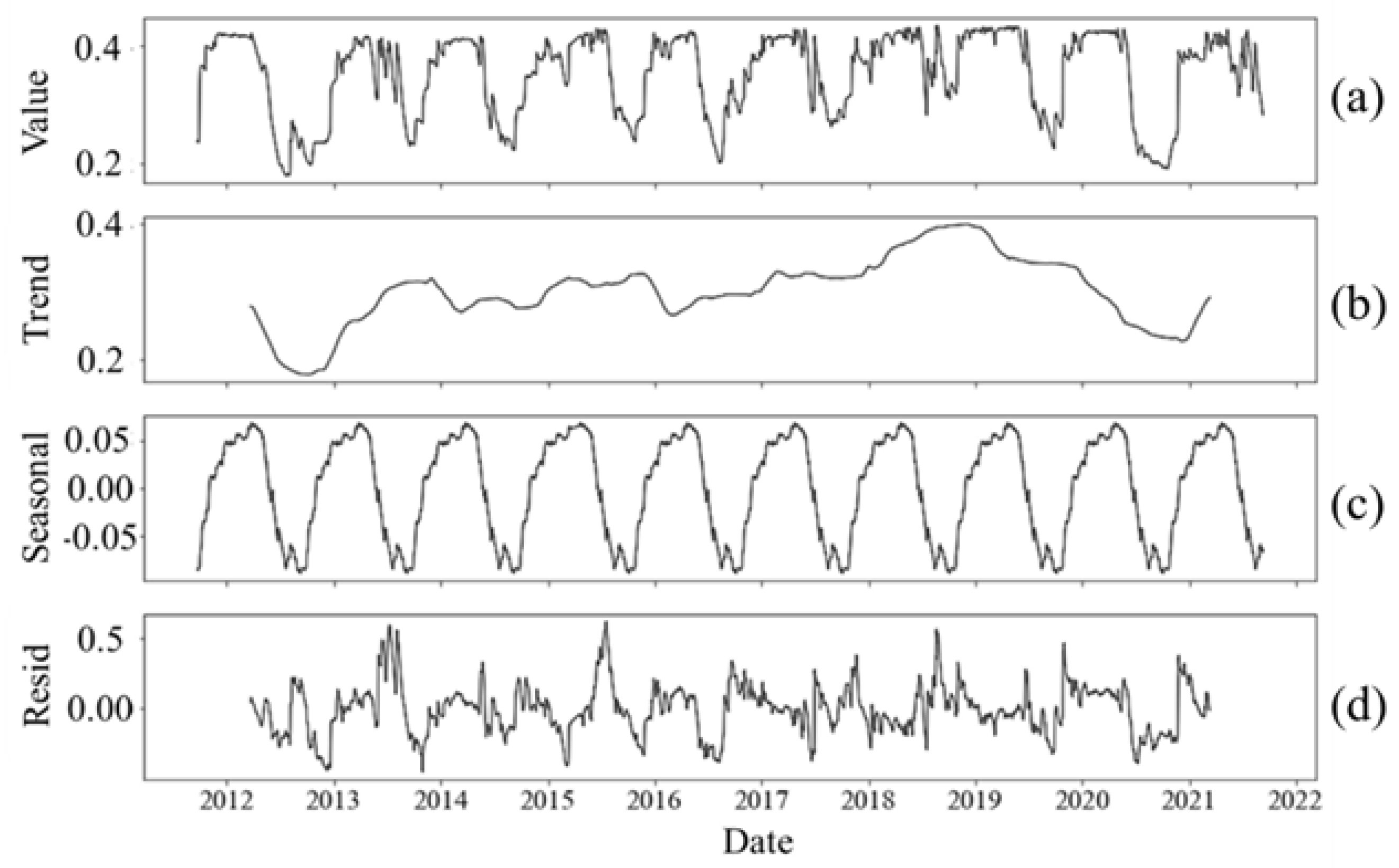

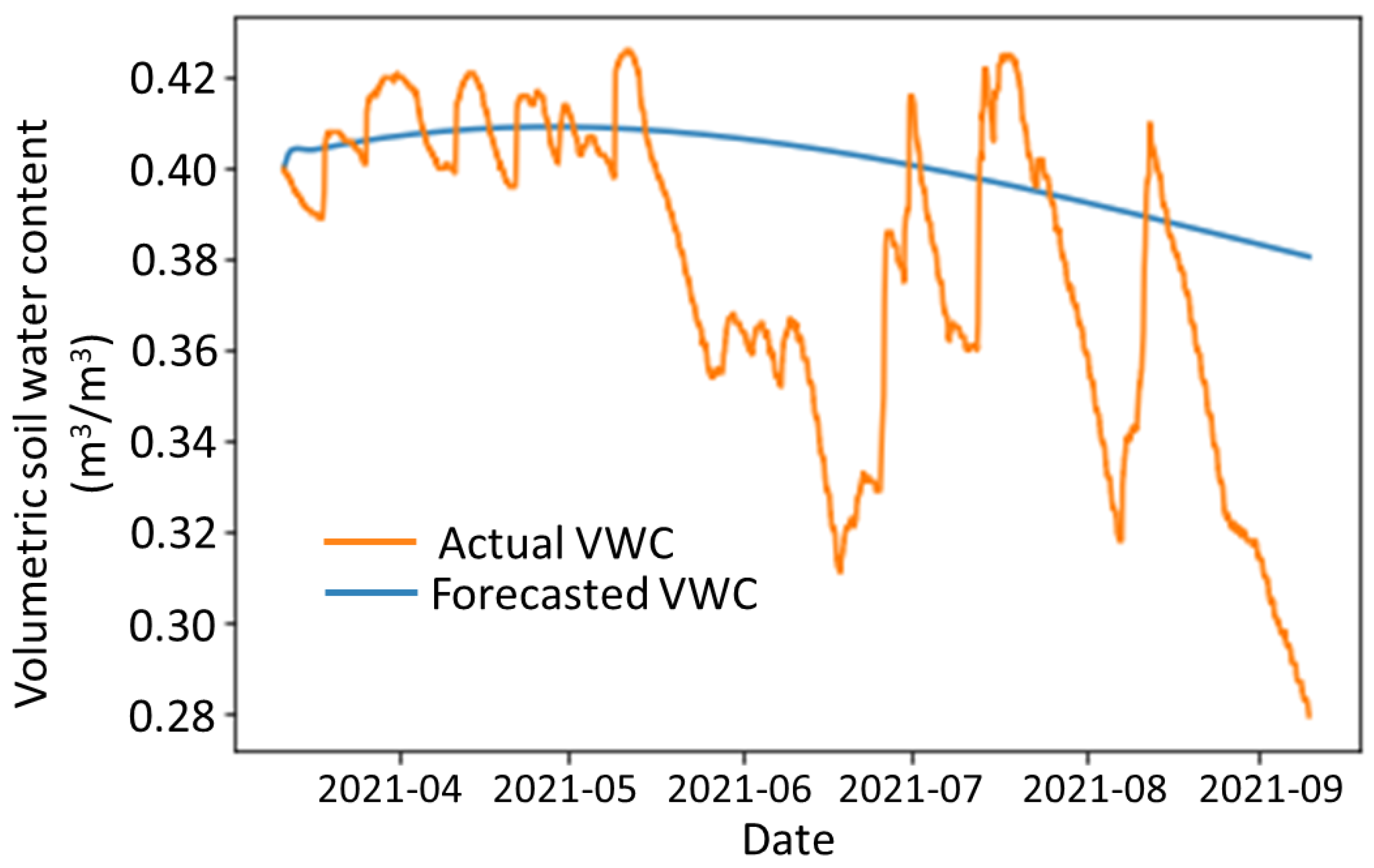

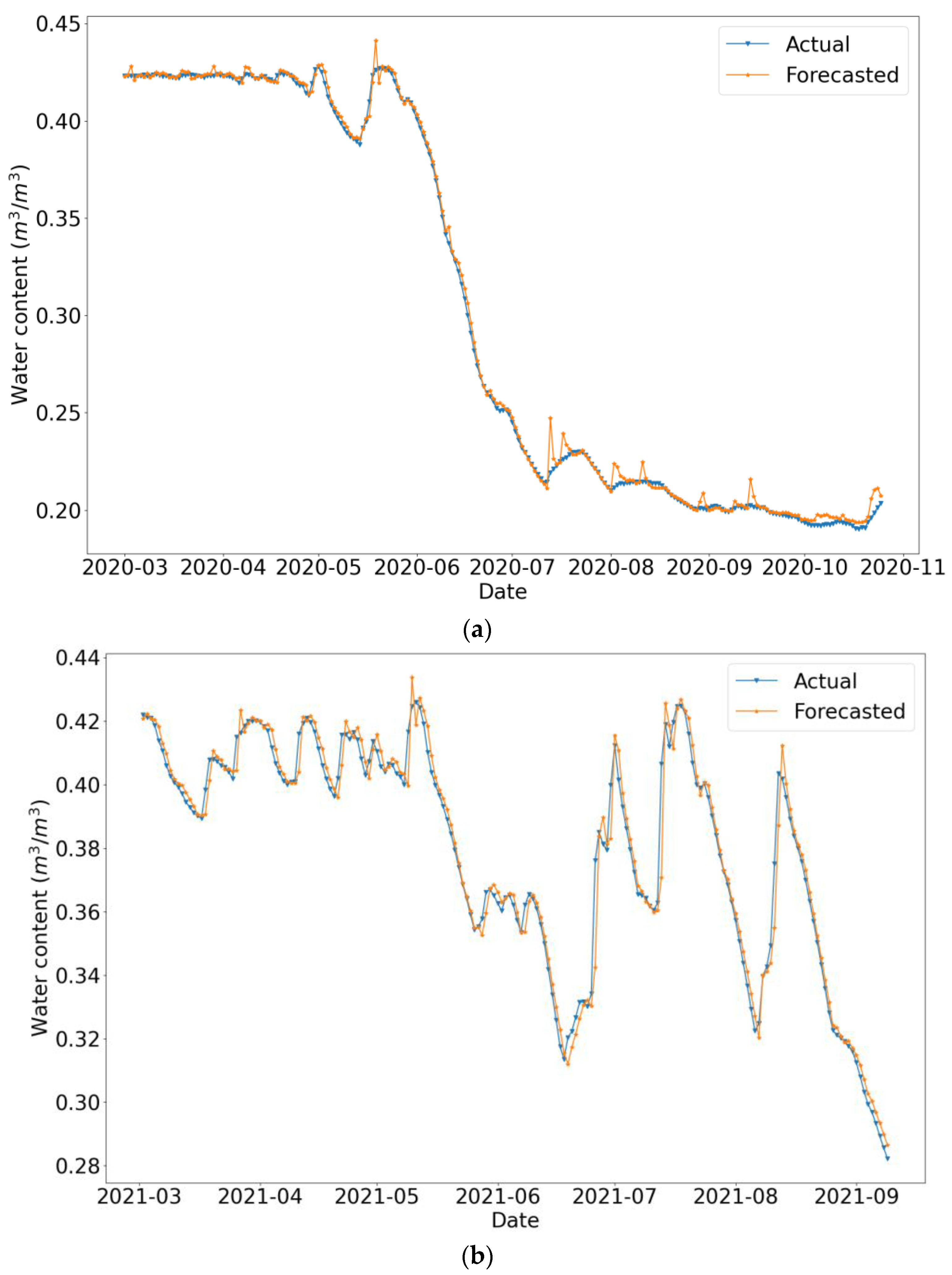
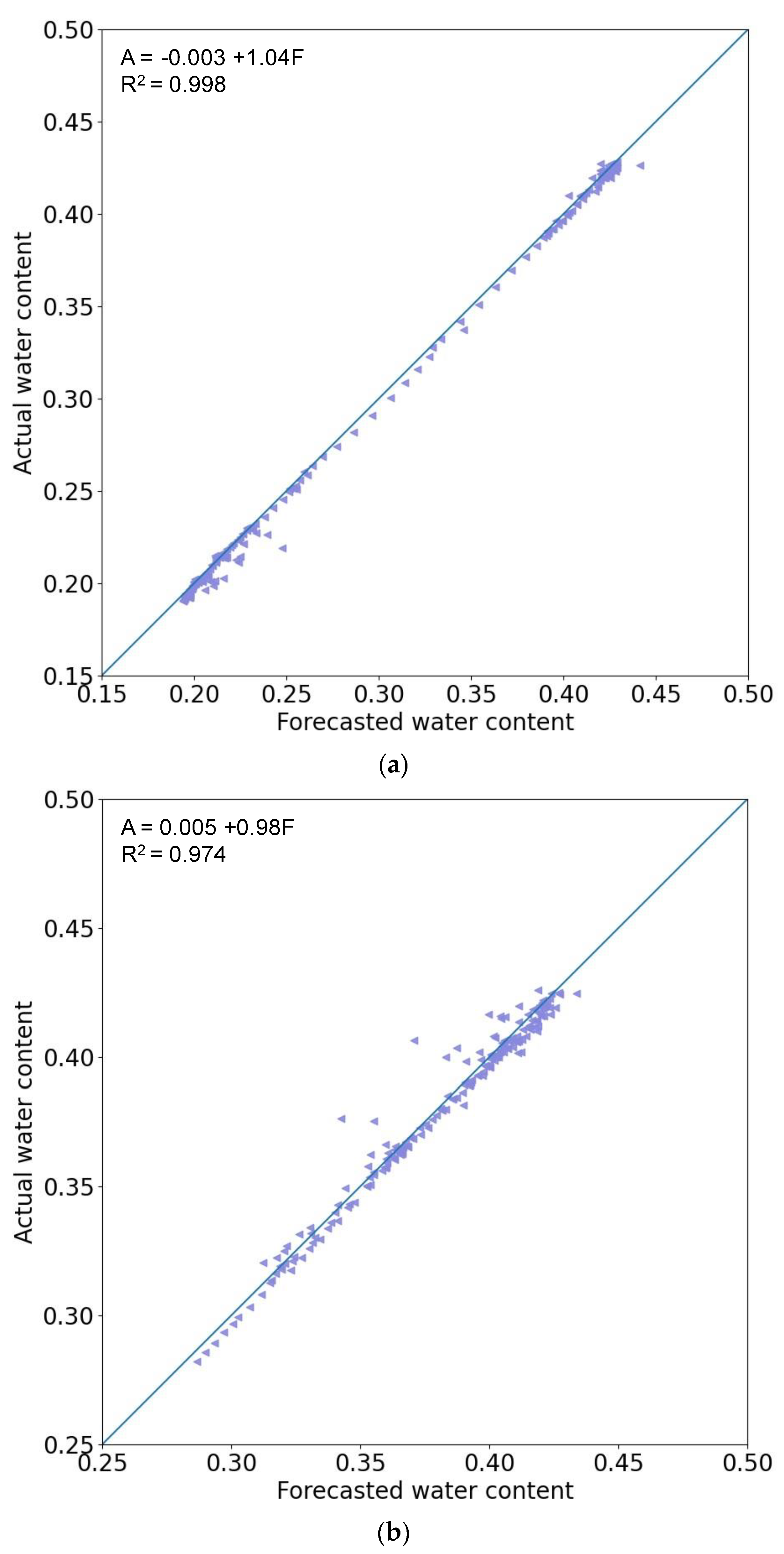
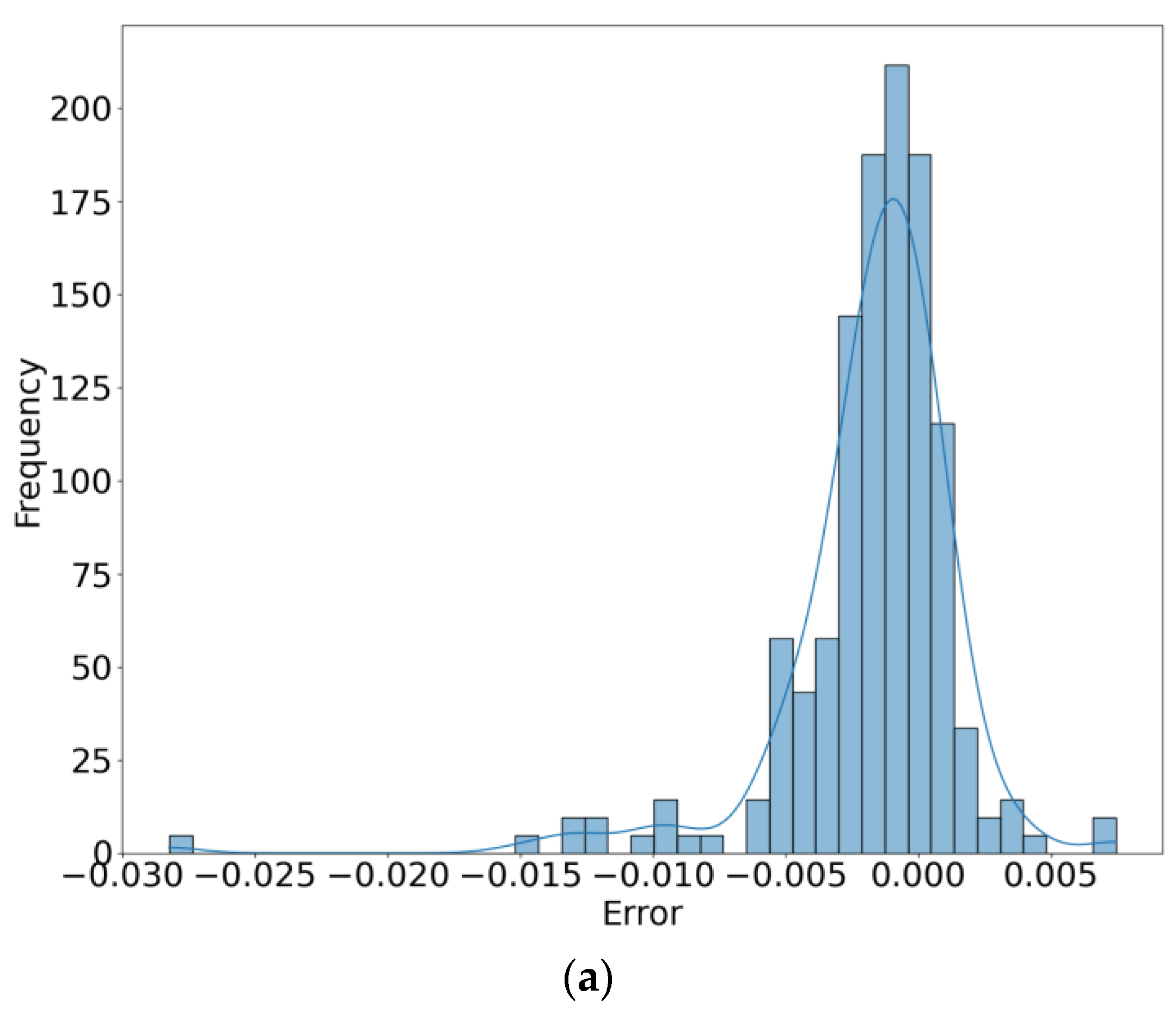

| Specifications | Description |
|---|---|
| Latitude | 41.2476079° |
| Longitude | −85.1182531° |
| Altitude | 266.65 m |
| Soil parent | Glacial till |
| Vegetation | Conservation/Prairie |
| Landscape | End moraine |
| Slope | 2–6% |
| Soil texture | Clay loam |
| Soil profile makeup | 0–17.78 cm: silt loam |
| Bulk density(g/cm3): 1.30–1.65 | |
| Average sand, silt, clay (%): 22, 52, 26 | |
| 17.78–63.5 cm: clay | |
| Bulk density(g/cm3): 1.45–1.70 | |
| Average sand, silt, clay (%): 22, 36, 42 | |
| 63.5–73.66 cm: clay loam | |
| Bulk density(g/cm3): 1.60–1.80 | |
| Average sand, silt, clay (%): 24, 40, 36 |
| Subject to Test | Name of the Test | Python Library Tool Used |
|---|---|---|
| Autocorrelation | Durbin-Watson test [38,39] | statmodels-stattools |
| Stationarity | Augmented Dickey-Fuller test (ADF) [40] | statmodels-stattools |
| Cointegration Test | Johansen’s cointegration test [41] | statmodels-stattools |
| Interdependency of variables | Granger causality test [42,43] | statmodels-stattools |
| Seasonality test | Seasonal decompose (additive) [44] | statmodels-tsa-seasonal_decompose |
| Lag Order | AIC |
|---|---|
| 0 | 7.956 |
| 1 | −0.7902 |
| 2 | −1.114 |
| 3 | −1.202 |
| 4 | −1.238 |
| 5 | −1.269 |
| 6 | −1.297 |
| 7 | −1.31 |
| 8 | −1.31 |
| 9 | −1.314 * |
| 10 | −1.314 |
| 11 | −1.306 |
| 12 | −1.3 |
| 13 | −1.293 |
| 14 | −1.283 |
| Layer (Type) | Nodes | Parameter | Activation Function |
|---|---|---|---|
| LSTM [1] | 128 | 69,120 | Tanh |
| LSTM [2] | 64 | 49,408 | Tanh |
| LSTM [3] | 32 | 12,416 | Tanh |
| Dense | 16 | 528 | ReLU * |
| Dense (output) | 1 | 33 | Linear |
| Variables | Durbin Watson Statistics |
|---|---|
| Total rainfall (mm) | 1.545 |
| Air temperature (°C) | 0.057 |
| Relative humidity (%) | 0.012 |
| Wind speed (ms−1) | 0.319 |
| Solar radiation (Wm−2) | 0.179 |
| Subsurface water content (m3m−3) | 0.0003 |
| Variables | ADF Statistics | p-Value | Critical Values | ||
|---|---|---|---|---|---|
| 1% | 5% | 10% | |||
| Total Rainfall (mm) | −24.382 | 2.00 × 10−6 | −3.432 | −2.862 | −2.567 |
| Air temperature (°C) | −3.251 | 1.72 × 10−2 | −3.432 | −2.862 | −2.567 |
| Relative humidity (%) | −5.339 | 5.00 × 10−6 | −3.432 | −2.862 | −2.567 |
| Wind Speed (ms−1) | −4.479 | 2.14 × 10−4 | −3.432 | −2.862 | −2.567 |
| Solar radiation (Wm−2) | −3.678 | 4.44 × 10−3 | −3.432 | −2.862 | −2.567 |
| Water content (m3m−3) | −4.384 | 3.17 × 10−4 | −3.432 | −2.862 | −2.567 |
| Variables | Test Stat | Critical Value at 95% Confidence Level |
|---|---|---|
| Total Rainfall (mm) | 1104 | 83.9 |
| Air temperature (°C) | 607 | 60.0 |
| Relative humidity (%) | 266 | 40.1 |
| Wind Speed (ms−1) | 120 | 24.2 |
| Solar radiation (Wm−2) | 33 | 12.3 |
| Variables | Total Rainfall (mm) | Air Temperature (°C) | Relative Humidity (%) | Wind Speed (ms−1) | Solar Radiation (Wm−2) | Water Content |
|---|---|---|---|---|---|---|
| Total Rainfall (mm) | 1.0 | <0.0001 | <0.0001 | <0.0001 | <0.0001 | 0.0002 |
| Air temperature (°C) | <0.0001 | 1.0 | <0.0001 | <0.0001 | <0.0001 | <0.0001 |
| Relative humidity (%) | <0.0001 | <0.0001 | 1.0 | <0.0001 | 0.0108 | 0.0004 |
| Wind Speed (ms−1) | <0.0001 | <0.0001 | <0.0001 | 1.0 | <0.0001 | <0.0001 |
| Solar radiation (Wm−2) | <0.0001 | <0.0001 | <0.0001 | <0.0001 | 1.0000 | <0.0001 |
| Water content (m3m−3) | <0.0001 | <0.0001 | <0.0001 | <0.0001 | <0.0001 | 1.0000 |
| Constant, A0 = 0.002924 | ||||||
|---|---|---|---|---|---|---|
| Coefficients (An) | ||||||
| Lag Order | Rainfall (A1) (mm) | Air Temperature (A2) (°C) | Relative Humidity (A3) (%) | Wind Speed (A4) (ms−1) | Solar Radiation (A5) (Wm−2) | Water Content (A6) (m3m−3) |
| L1 | 8.100 × 10−3 | 1.200 × 10−4 | 1.700 × 10−5 | −2.900 × 10−4 | −1.000 × 10−5 | 1.295 × 100 |
| L2 | −2.340 × 10−3 | −1.000 × 10−5 | 1.900 × 10−5 | 3.900 × 10−4 | 2.100 × 10−6 | −3.150 × 10−1 |
| L3 | 2.600 × 10−4 | −3.100 × 10−5 | −2.100 × 10−5 | −8.900 × 10−5 | −1.700 × 10−6 | 3.920 × 10−2 |
| L4 | 6.200 × 10−4 | 2.800 × 10−5 | 1.300 × 10−5 | 2.800 × 10−4 | 0.000 | −1.690 × 10−2 |
| L5 | −2.100 × 10−4 | −7.900 × 10−5 | 8.800 × 10−6 | 5.400 × 10−4 | −1.300 × 10−6 | −1.100 × 10−3 |
| L6 | −1.400 × 10−4 | −1.900 × 10−6 | −3.500 × 10−5 | −2.700 × 10−4 | −1.100 × 10−6 | −2.130 × 10−2 |
| L7 | 2.700 × 10−4 | −1.500 × 10−5 | 1.900 × 10−5 | −2.000 × 10−4 | 0.000 | 1.600 × 10−2 |
| L8 | −4.300 × 10−4 | 3.600 × 10−5 | −1.500 × 10−5 | 1.100 × 10−4 | 1.200 × 10−6 | 3.000 × 10−3 |
| L9 | −5.400 × 10−4 | −7.800 × 10−5 | 1.200 × 10−5 | −1.300 × 10−5 | 1.900 × 10−6 | −1.120 × 10−2 |
| Parameters | Values |
|---|---|
| MAE (m3m−3) | 0.0561 |
| MSE (m3m−3)2 | 0.0046 |
| RMSE (m3m−3) | 0.03821 |
| R2 | 0.698 |
| Durbin-Watson statistics | 2.00 |
| Parameters | Training | Validation |
|---|---|---|
| Mean absolute error (m3m−3) | 0.0093 | 0.0098 |
| Mean absolute percentage error (MAPE) | 3.12% | 1.29% |
| Mean squared error (m3m−3)2 | 0.00031 | 0.00041 |
| R squared | 0.995 | 0.981 |
| Cost delta (m3m−3) | 0.0005 (5.37% of training MAE) | |
| Overfitting ratio (OR) [61] | 0.93 | |
| Parameters | Test for Corn Cropping Season 2020 | Test for Corn Cropping Season 2021 |
|---|---|---|
| R2 | 0.998 | 0.973 |
| Mean absolute error (MAE) (m3m−3) | 0.00237 | 0.00368 |
| Mean squared error (MSE) (m3m−3)2 | 0.000015 | 0.000033 |
| Root mean squared error (RMSE) (m3m−3) | 0.00382 | 0.00577 |
| Overall performance index (OI) | 0.992 | 0.966 |
Disclaimer/Publisher’s Note: The statements, opinions and data contained in all publications are solely those of the individual author(s) and contributor(s) and not of MDPI and/or the editor(s). MDPI and/or the editor(s) disclaim responsibility for any injury to people or property resulting from any ideas, methods, instructions or products referred to in the content. |
© 2024 by the authors. Licensee MDPI, Basel, Switzerland. This article is an open access article distributed under the terms and conditions of the Creative Commons Attribution (CC BY) license (https://creativecommons.org/licenses/by/4.0/).
Share and Cite
Basir, M.S.; Noel, S.; Buckmaster, D.; Ashik-E-Rabbani, M. Enhancing Subsurface Soil Moisture Forecasting: A Long Short-Term Memory Network Model Using Weather Data. Agriculture 2024, 14, 333. https://doi.org/10.3390/agriculture14030333
Basir MS, Noel S, Buckmaster D, Ashik-E-Rabbani M. Enhancing Subsurface Soil Moisture Forecasting: A Long Short-Term Memory Network Model Using Weather Data. Agriculture. 2024; 14(3):333. https://doi.org/10.3390/agriculture14030333
Chicago/Turabian StyleBasir, Md. Samiul, Samuel Noel, Dennis Buckmaster, and Muhammad Ashik-E-Rabbani. 2024. "Enhancing Subsurface Soil Moisture Forecasting: A Long Short-Term Memory Network Model Using Weather Data" Agriculture 14, no. 3: 333. https://doi.org/10.3390/agriculture14030333
APA StyleBasir, M. S., Noel, S., Buckmaster, D., & Ashik-E-Rabbani, M. (2024). Enhancing Subsurface Soil Moisture Forecasting: A Long Short-Term Memory Network Model Using Weather Data. Agriculture, 14(3), 333. https://doi.org/10.3390/agriculture14030333





